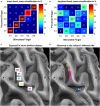Case Report: Plasticity in Central Sensory Finger Representation and Touch Perception After Microsurgical Reconstruction of Infraclavicular Brachial Plexus Injury
- PMID: 35281503
- PMCID: PMC8914191
- DOI: 10.3389/fnins.2022.793036
Case Report: Plasticity in Central Sensory Finger Representation and Touch Perception After Microsurgical Reconstruction of Infraclavicular Brachial Plexus Injury
Abstract
After brachial plexus injury (BPI), early microsurgery aims at facilitating reconnection of the severed peripheral nerves with their orphan muscles and sensory receptors and thereby reestablishing communication with the brain. In order to investigate this sensory recovery, here we combined functional magnetic resonance imaging (fMRI) and tactile psychophysics in a patient who suffered a sharp, incomplete amputation of the dominant hand at the axilla level. To determine somatosensory detection and discomfort thresholds as well as sensory accuracy for fingers of both the intact and affected hand, we used electrotactile stimulation in the framework of a mislocalization test. Additionally, tactile stimulation was performed in the MRI scanner in order to determine the cortical organization of the possibly affected primary somatosensory cortex. The patient was able to detect electrotactile stimulation in 4 of the 5 fingertips (D1, D2, D4, D5), and in the middle phalanx in D3 indicating some innervation. The detection and discomfort threshold were considerably higher at the affected side than at the intact side, with higher detection and discomfort thresholds for the affected side. The discrimination accuracy was rather low at the affected side, with stimulation of D1/D2/D3/D4/D5 eliciting most commonly a sensation at D4/D1/D3/D2/D5, respectively. The neuroimaging data showed a mediolateral succession from D2 to D5 to D1 to D4 (no activation was observed for D3). These results indicate a successful regrowth of the peripheral nerve fibers from the axilla to four fingertips. The data suggest that some of the fibers have switched location in the process and there is a beginning of cortical reorganization in the primary somatosensory cortex, possibly resulting from a re-education of the brain due to conflicting information (touch vs. vision).
Keywords: S1; brachial plexus injury; brain plasticity; sensory cortex; somatosensory.
Copyright © 2022 Ernst, Weiss, Wanke, Frahm, Felmerer, Farina, Schilling and Wilke.
Conflict of interest statement
The authors declare that the research was conducted in the absence of any commercial or financial relationships that could be construed as a potential conflict of interest.
Figures



Similar articles
-
Tactile acuity of fingertips and hand representation size in human Area 3b and Area 1 of the primary somatosensory cortex.Neuroimage. 2021 May 15;232:117912. doi: 10.1016/j.neuroimage.2021.117912. Epub 2021 Feb 27. Neuroimage. 2021. PMID: 33652142
-
The utility of various sensory nerve conduction responses in assessing brachial plexopathies.Muscle Nerve. 1995 Aug;18(8):879-89. doi: 10.1002/mus.880180813. Muscle Nerve. 1995. PMID: 7630350
-
Patterns of cortical reorganization parallel impaired tactile discrimination and pain intensity in complex regional pain syndrome.Neuroimage. 2006 Aug 15;32(2):503-10. doi: 10.1016/j.neuroimage.2006.03.045. Epub 2006 Jun 6. Neuroimage. 2006. PMID: 16753306
-
Integrated technology for evaluation of brain function and neural plasticity.Phys Med Rehabil Clin N Am. 2004 Feb;15(1):263-306. doi: 10.1016/s1047-9651(03)00124-4. Phys Med Rehabil Clin N Am. 2004. PMID: 15029909 Review.
-
The peripheral dopaminergic system: morphological analysis, functional and clinical applications.Ital J Anat Embryol. 2002 Jul-Sep;107(3):145-67. Ital J Anat Embryol. 2002. PMID: 12437142 Review.
References
Publication types
LinkOut - more resources
Full Text Sources

